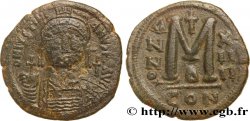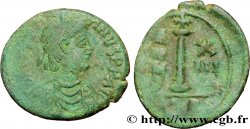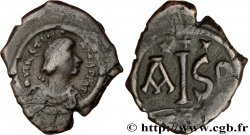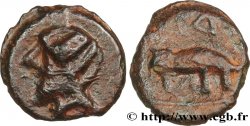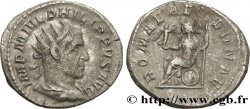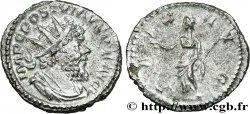v45_0867 - JUSTINIAN I Solidus
MONNAIES 45 (2010)
Starting price : 1 200.00 €
Estimate : 2 200.00 €
Realised price : 1 200.00 €
Number of bids : 1
Maximum bid : 1 375.00 €
Starting price : 1 200.00 €
Estimate : 2 200.00 €
Realised price : 1 200.00 €
Number of bids : 1
Maximum bid : 1 375.00 €
Type : Solidus
Date: indiction 12
Date: 548-549
Mint name / Town : Carthage
Metal : gold
Millesimal fineness : 1000 ‰
Diameter : 19,5 mm
Orientation dies : 6 h.
Weight : 4,46 g.
Rarity : R3
Coments on the condition:
Exemplaire sur un petit flan parfaitement centré des deux côtés. Très beau portrait avec une faiblesse de frappe sur le visage. Frappe un peu molle au revers, mais haut relief et finement détaillé. Belle patine de collection ancienne
Predigree :
Cet exemplaire provient de la collection A. S.
Obverse
Obverse legend : D N IVSTINI-ANVS PP AVG.
Obverse description : Buste diadémé, couronné et cuirassé de Justinien Ier de face, tenant le globe crucigère de la main droite et un bouclier orné d'un cavalier de la gauche (N1'a) ; diadème perlé.
Obverse translation : “Dominus Noster Iustinianus Perpetuus Augustus”, (Notre seigneur Justinien perpétuel auguste).
Reverse
Reverse legend : VICTORI-A AVGGGIB/ -|*// CONOB.
Reverse description : Ange debout de face, les ailes déployées, tenant une longue croix de la main droite et un globe crucigère de la main gauche ; étoile à huit rais.
Reverse translation : “Victoria Augustorum” (La Victoire des augustes).
Commentary
Casque avec plumet. Diadème perlé. Cuirasse cloutée et épaulière décorée. Pendilia aux extrémités bouletées. Bouclier orné d’un cavalier galopant à droite, terrassant un ennemi (stylisé). Au revers, croix longue non chrismée. Style très particulier, “africain” DOC I, p. 159, note 277c-e : “The coins with (gamma) constitute a different problem since these officinae operated also in Constantinople and the products can be distinguished only by style. Lafaurie, however, believes that style and fabric identify some specimens as African. Grierson had indepedently classed these as African”. Sur cet exemplaire, en fin de légende de revers, le B semble regravé sur un A correspondant à la onzième année de règne soit 547-548. Normalement la marque IA associée aux lettres d’exergue AFR, n’est recensé que pour l’unique solidi du Cabinet des médailles de la BnF avec AFR pour Afrique (Morisson 1 = BN/B. 01, trouvé en Tunisie en 1960 et publié par Jean Lafaurie, Un solidus inédit de Justinien Ier frappé en Afrique”, RN, 1962, p. 167-182). Jean Lafaurie, pensait, suivant Nadia Kapamadji que les solidi avec les marques IA et IB étaient bien de l’atelier de Carthage et que les onzième et douzième officines avaient été envoyées depuis Constantinople pour l’ouverture de l’atelier de Carthage. Pour P. Grierson ces émissions sont datées entre 534 et 545 et sont bien identifiées pour l’atelier de Carthage avec un style constantinopolitain et certaines de ces pièces sont bien de Constantinople. Seul le style permet de trancher et de les attribuer à l’atelier de Carthage. Pour W. Hahn (MIB), nous avons les pièces IA (Africa) et IB des onzième et douzième année (537/538 et 538/539) et nous trouvons ensuite des solidi avec les indictions 3, (539/540), 9 (545/546), 10 (546/547) et 11 (547/548). La production d’or s’arrête ensuite pour ne reprendre que sous Justin II. Pour Cécile Morrisson, les pièces avec IB sont bien de l’indiction 12 (548/549). Pour l’indiction 12, nous avons seulement trois exemplaires recensés : 1) n° 88 exemplaire de la collection Nadia Kapamadji (SB. 144 = Vente Bourgey n° 128) ; 2) n° 89, Do. 277b provenant de la collection Grierson et de la vente Platt du 1er septembre 1959 ; 3) n° 90, enfin l’exemplaire de l’American Numismatic Society acquis en 1968. Semble de même coin de droit que l’exemplaire de la collection du Dumbraton Oaks (Do. 277b). C’est le quatrième exemplaire publié avec trois coins de droit et quatre coins de revers.
Helmet with plume. Pearl tiara. Studded breastplate and decorated shoulder guard. Pendilia with pelleted ends. Shield decorated with a horseman galloping to the right, defeating an enemy (stylized). On the reverse, long, unchrismated cross. Very particular style, “African” DOC I, p. 159, note 277c-e: “The coins with (gamma) constitute a different problem since these officinae operated also in Constantinople and the products can be distinguished only by style. Lafaurie, however, believes that style and fabric identify some specimens as African. Grierson had independently classified these as African”. On this example, at the end of the reverse legend, the B seems to be re-engraved on an A corresponding to the eleventh year of the reign, i.e. 547-548. Normally the IA mark associated with the exergue letters AFR is only recorded for the single solidi of the Cabinet of medals of the BnF with AFR for Africa (Morisson 1 = BN/B. 01, found in Tunisia in 1960 and published by Jean Lafaurie, An unpublished solidus of Justinian I struck in Africa”, RN, 1962, p.. 167-182). Jean Lafaurie, thought, following Nadia Kapamadji, that the solidi with the marks IA and IB were indeed from the Carthage workshop and that the eleventh and twelfth officinae had been sent from Constantinople for the opening of the Carthage workshop.. For P. Grierson these issues are dated between 534 and 545 and are well identified for the workshop of Carthage with a Constantinopolitan style and some of these pieces are indeed from Constantinople. Only the style allows us to decide and attribute them to the Carthage workshop.. For W. Hahn (MIB), we have the coins IA (Africa) and IB of the eleventh and twelfth year (537/538 and 538/539) and then we find solidi with the indictions 3, (539/540), 9 (545/546), 10 (546/547) and 11 (547/548). Gold production then stopped and only resumed under Justin II.. For Cécile Morrisson, the pieces with IB are indeed from indiction 12 (548/549). For indiction 12, we have only three examples listed: 1) No. 88 example from the Nadia Kapamadji collection (SB. 144 = Bourgey sale no. 128); 2) No. 89, C. 277b from the Grierson collection and the Platt sale of September 1, 1959; 3) No. 90, finally the example of the American Numismatic Society acquired in 1968. Appears to have the same obverse as the example in the Dumbraton Oaks collection (Do. 277b). This is the fourth example published with three obverse corners and four reverse dies
Helmet with plume. Pearl tiara. Studded breastplate and decorated shoulder guard. Pendilia with pelleted ends. Shield decorated with a horseman galloping to the right, defeating an enemy (stylized). On the reverse, long, unchrismated cross. Very particular style, “African” DOC I, p. 159, note 277c-e: “The coins with (gamma) constitute a different problem since these officinae operated also in Constantinople and the products can be distinguished only by style. Lafaurie, however, believes that style and fabric identify some specimens as African. Grierson had independently classified these as African”. On this example, at the end of the reverse legend, the B seems to be re-engraved on an A corresponding to the eleventh year of the reign, i.e. 547-548. Normally the IA mark associated with the exergue letters AFR is only recorded for the single solidi of the Cabinet of medals of the BnF with AFR for Africa (Morisson 1 = BN/B. 01, found in Tunisia in 1960 and published by Jean Lafaurie, An unpublished solidus of Justinian I struck in Africa”, RN, 1962, p.. 167-182). Jean Lafaurie, thought, following Nadia Kapamadji, that the solidi with the marks IA and IB were indeed from the Carthage workshop and that the eleventh and twelfth officinae had been sent from Constantinople for the opening of the Carthage workshop.. For P. Grierson these issues are dated between 534 and 545 and are well identified for the workshop of Carthage with a Constantinopolitan style and some of these pieces are indeed from Constantinople. Only the style allows us to decide and attribute them to the Carthage workshop.. For W. Hahn (MIB), we have the coins IA (Africa) and IB of the eleventh and twelfth year (537/538 and 538/539) and then we find solidi with the indictions 3, (539/540), 9 (545/546), 10 (546/547) and 11 (547/548). Gold production then stopped and only resumed under Justin II.. For Cécile Morrisson, the pieces with IB are indeed from indiction 12 (548/549). For indiction 12, we have only three examples listed: 1) No. 88 example from the Nadia Kapamadji collection (SB. 144 = Bourgey sale no. 128); 2) No. 89, C. 277b from the Grierson collection and the Platt sale of September 1, 1959; 3) No. 90, finally the example of the American Numismatic Society acquired in 1968. Appears to have the same obverse as the example in the Dumbraton Oaks collection (Do. 277b). This is the fourth example published with three obverse corners and four reverse dies







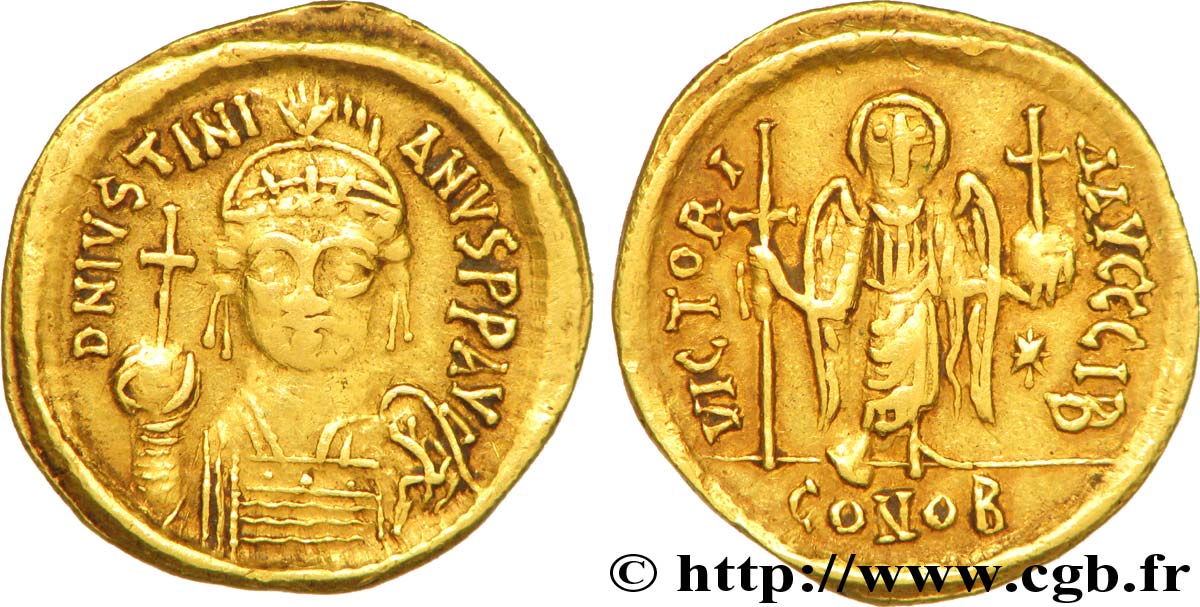
 Report a mistake
Report a mistake Print the page
Print the page Share my selection
Share my selection Ask a question
Ask a question Consign / sell
Consign / sell
 Full data
Full data